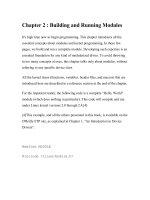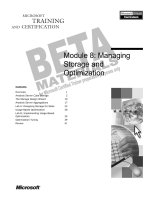Module Linux essentials - Module 11: Managing packages and processes
Bạn đang xem bản rút gọn của tài liệu. Xem và tải ngay bản đầy đủ của tài liệu tại đây (226.28 KB, 39 trang )
Module 11
Managing Packages and
Processes
This slide deck is for LPI Academy instructors to use for lectures for LPI Academy courses.
©Copyright Network Development Group 2013.
Exam Objective
4.3 Where Data is Stored
Objective Summary
–
–
–
Understanding kernel and processes
Logging utilities such as syslog, klog, and
dmesg
Information Storage Paths
This slide deck is for LPI Academy instructors to use for lectures for LPI Academy courses.
©Copyright Network Development Group 2013.
Working with Package
Management
This slide deck is for LPI Academy instructors to use for lectures for LPI Academy courses.
©Copyright Network Development Group 2013.
Package Management
•
•
•
Package management is a system for installing,
configuring, updating, querying and removing software
from a Linux system.
Package management systems ensure that software
functions by tracking prerequisites or dependencies
between packages.
There are many different package management systems
available, but two dominate the Linux landscape:
–
–
Debian Package Management
RPM Package Management
This slide deck is for LPI Academy instructors to use for lectures for LPI Academy courses.
©Copyright Network Development Group 2013.
Debian Package Management
•
•
•
•
•
Used by the Debian distribution and its popular
derivatives such as Ubuntu and Mint.
A software package is distributed as a ".deb" file, which
contains the files and meta-information for the package.
The lowest level tool (back-end command) is dpkg
Command line front-end tools include:
– apt-get
– aptitude
GUI front-end tools include:
– synaptic
– software-center
This slide deck is for LPI Academy instructors to use for lectures for LPI Academy courses.
©Copyright Network Development Group 2013.
Adding Packages (Debian)
•
•
•
•
To ensure your list of packages is current, first execute:
– sudo apt-cache update
To search for a package, you can use:
– sudo apt-cache search keyword
To install a package, run:
– sudo apt-get install package
Due to dependencies, if you want to install one package,
you may have to install other packages, too.
This slide deck is for LPI Academy instructors to use for lectures for LPI Academy courses.
©Copyright Network Development Group 2013.
Updating Packages (Debian)
•
•
•
If you want to update an individual package, then you
perform the command that will install that package:
– sudo apt-get install package
If you want to update all packages, then you can
execute:
– sudo apt-get upgrade
Users with a graphical login may notice update
notifications from the update-manager
This slide deck is for LPI Academy instructors to use for lectures for LPI Academy courses.
©Copyright Network Development Group 2013.
Removing Packages (Debian)
•
•
•
Due to dependencies between packages, if you want to
remove one package of software, then you may end up
having to remove other packages as well.
If you want to remove all files from a software package
except the configuration files, then you can execute:
– sudo apt-get remove package
If you want to remove all files from a software package
including the configuration files, then you can execute:
– sudo apt-get --purge remove package
This slide deck is for LPI Academy instructors to use for lectures for LPI Academy courses.
©Copyright Network Development Group 2013.
Querying Packages (Debian)
•
•
•
•
To get a list of all installed packages:
– dpkg -l
To list all the files of a package:
– dpkg -L package
To query a package for information and its state:
– dpkg -s package
To determine if an file was provided by a package:
– dpkg -S /path/to/file
This slide deck is for LPI Academy instructors to use for lectures for LPI Academy courses.
©Copyright Network Development Group 2013.
RPM-based Management
This slide deck is for LPI Academy instructors to use for lectures for LPI Academy courses.
©Copyright Network Development Group 2013.
RPM Package Management
•
•
•
•
The Linux Standards Base, which is a Linux Foundation
project, develops through consensus a set of standards
that increase the compatibility between conforming Linux
systems.
According to the Linux Standards Base, the standard
package management system is RPM, or RPM Package
Management, a recursive acronym.
RPM Package Management tracks dependencies
between packages and was developed by Red Hat.
Distributions derived from Red Hat like (Centos and
Fedora) and some of those that are not (SUSE,
OpenSUSE and Mandriva) use RPM.
This slide deck is for LPI Academy instructors to use for lectures for LPI Academy courses.
©Copyright Network Development Group 2013.
RPM Package Management
•
•
•
•
•
The low level, back-end tool for RPM Package
Management is the rpm command.
Command line front-end tools include yum and
up2date, which can perform automatic dependency
resolution.
Graphical front-end tools such as yumex and gpkapplication simplify the process of package
management.
Commands that query the packages can be performed
by any user.
Commands that install, update or remove system
packages must be executed with root privileges.
This slide deck is for LPI Academy instructors to use for lectures for LPI Academy courses.
©Copyright Network Development Group 2013.
•
Adding/Updating Packages
(RPM)
To be able to find the package that you want to install:
yum search keyword
To install a package and its dependencies:
– yum install package
To install an update for an individual package:
– yum update package
To update all packages run:
– yum update
If updates are available when a user performs a graphical
login, then a message in the notification area may appear
from gpk-update-viewer indicating that updates are
available.
This slide deck is for LPI Academy instructors to use for lectures for LPI Academy courses.
–
•
•
•
•
©Copyright Network Development Group 2013.
Removing Packages (RPM)
•
•
If you want to remove a package with the rpm
command, then you may need to remove
manually other packages, as well, due to the
dependencies between packages.
To remove a package and the packages that
depend on it:
–
yum remove package
This slide deck is for LPI Academy instructors to use for lectures for LPI Academy courses.
©Copyright Network Development Group 2013.
Querying Packages (RPM)
•
•
•
•
•
While it is possible to perform some queries with yum,
the rpm command will work faster because it uses a
local database instead of having to connect over the
network to repositories of software.
To query to get a list of all installed packages:
– rpm -qa
To get the list of the files that are in a package:
– rpm -ql package
To query a package for its information or state:
– rpm -qi package
To determine if a file belongs to a package:
– rpm -qf /path/to/file
This slide deck is for LPI Academy instructors to use for lectures for LPI Academy courses.
©Copyright Network Development Group 2013.
Understanding Processes
This slide deck is for LPI Academy instructors to use for lectures for LPI Academy courses.
©Copyright Network Development Group 2013.
The Linux Kernel
•
•
•
•
When most people refer to Linux, they are actually
referring to GNU/Linux the operating system.
GNU (Gnu's Not Unix) provides the open source
equivalents to most common Unix commands, like ls, cp
or passwd.
Linux is the core of the operating system, the kernel,
which manages every aspect of a running system.
Key functions of the Linux kernel include:
– managing booting the operating system, processes,
memory, filesystem, networking and device drivers.
– accepting commands from the user and managing
processes that carry out those commands by
This slide deck is for LPI Academy instructors to use for lectures for LPI Academy courses.
accessing
various devices.
©Copyright Network Development Group 2013.
The /proc directory
•
The /proc directory contains a pseudo-filesystem
which contains several types of information:
–
directories that have names matching the PID of
processes on the system which contain numerous
files with information about the process.
–
files like cmdline, meminfo and modules which
contain information about the system.
–
files in /proc/sys that are writable by the root
user and can immediately change the way that the
kernel operates.
•
to make kernel changes permanent, add entries to the
/etc/sysctl.conf file.
This slide deck is for LPI Academy instructors to use for lectures for LPI Academy courses.
©Copyright Network Development Group 2013.
Process Hierarchy
•
•
•
•
After the kernel finishes loading, it starts the first process
(typically /sbin/init) and assigns it the PID of 1.
Each additional process that gets started is assigned a
PID in sequential order.
As /sbin/init starts up other processes (or other
processes start up processe) they are considered parent
processes and
The processes that were started by the parent processes
are called child processes.
This slide deck is for LPI Academy instructors to use for lectures for LPI Academy courses.
©Copyright Network Development Group 2013.
Process Hierarchy
•
•
When the system has been running long enough, it may
eventually reach the maximum PID value, which can be
viewed and configured through
/proc/sys/kernel/pid_max.
Once the largest PID is used, the system will "roll over"
and resume by assigning PID values that are available at
the bottom of the range.
This slide deck is for LPI Academy instructors to use for lectures for LPI Academy courses.
©Copyright Network Development Group 2013.
Viewing the Process Hierarchy
The pstree command can show the process hierarchy
with “text art”:
This slide deck is for LPI Academy instructors to use for lectures for LPI Academy courses.
©Copyright Network Development Group 2013.
An Example of Process
Hierarchy
If you were to look at the parent-child relationships
involved in executing the pstree command, it
would look something like this:
init
login
bash
pstree
This slide deck is for LPI Academy instructors to use for lectures for LPI Academy courses.
©Copyright Network Development Group 2013.
The Process (ps) Command
•
•
•
By default, the process (ps) command will only show the
processes running in the current shell.
The ps --forest option will display lines to indicate
parent and child relationships, similar to the pstree
command.
The ps command accepts three kinds of options:
– Traditional Unix options given with a single dash
– BSD Unix options given without any dash
– GNU long options given with two dashes
This slide deck is for LPI Academy instructors to use for lectures for LPI Academy courses.
©Copyright Network Development Group 2013.
Viewing All Processes
•
•
To view all processes execute ps aux or ps
-ef.
Since hundreds of processes are normally
present, piping the output to grep can be useful
to find the information about a particular
process:
$ ps -ef | grep firefox
sysadmin 4048 2380 10 16:37 pts/0
00:00:01 /usr/lib/firefox/firefox
sysadmin 4096 2380 0 16:38 pts/0
00:00:00 grep firefox
This slide deck is for LPI Academy instructors to use for lectures for LPI Academy courses.
©Copyright Network Development Group 2013.
Monitoring the system
This slide deck is for LPI Academy instructors to use for lectures for LPI Academy courses.
©Copyright Network Development Group 2013.









